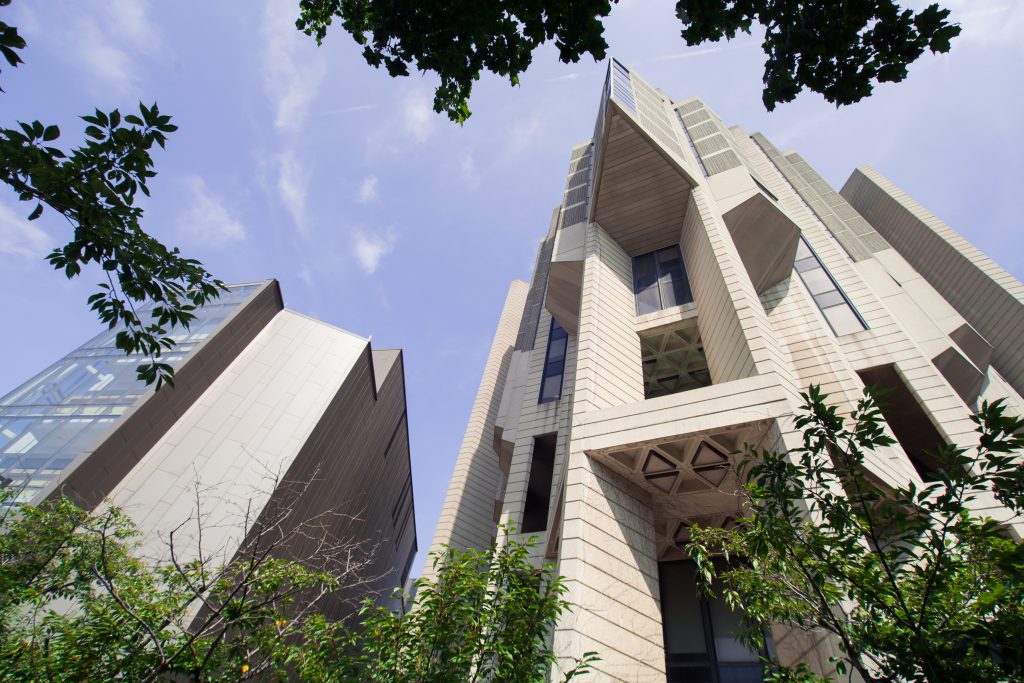Deferred maintenance
Deferred maintenance describes the major infrastructure renewals and upgrades that have been delayed due to budget or resource constraints.
Unlike regular maintenance, deferred maintenance involves capital investment aimed at preserving, enhancing and future-proofing our campus.
Deferred maintenance includes strategic projects like roof replacements, HVAC upgrades and building repairs.
Managing deferred maintenance is critical to prevent minor issues escalating into major system failures—which increase operating costs and negatively impact the campus community. But on a large, historic campus, there is always a long list of things to do.

Photo by Hanna Borodina.
How do we prioritize deferred maintenance needs?
As stewards of the historic St. George campus, Facilities & Services uses an evidence-based, multi-factor model to identify the projects that are most critical for the campus community.
1. Audit
Every five years, each building on campus is audited to assess its age, condition and design compliance, informing planning of and budgeting for future upgrades. Audit results, property acquisitions, usage changes and planned updates are logged in a centralized, inflation-adjusted database, providing a complete view of campus infrastructure needs in the coming years.
2. Assess
To prioritize deferred maintenance projects as fairly as possible given the resources available, F&S uses an evidence-based multi-factor model. Every building element is given a score out of five, based on four weighted categories. The greater the risk or impact of an issue on campus users and infrastructure, the higher the score. The highest-scoring issues are prioritized for the following year. Criteria weightings are periodically reviewed by key stakeholders.
Prioritization criteria & weighting
Physical condition (45%) measures the physical condition of building elements (prioritizing elements in critical condition).
Impact on users (36%) measures the extent a failure would have on occupants and users of the building (prioritizing widespread over localized disruption).
Fabric impacts of failure (15%) measures the impact a failure would have on the rest of the building (prioritizing issues with the potential to cause widespread damage).
Building use (4%) measures the impact on the university’s core mission (prioritizing academic and research functions).

Physical condition (45%) is shown in dark blue, impact on users (36%) is shown in teal, fabric impacts of failure (15%) is shown in red, and building use (4%) is shown in yellow.
3. Act
Work gets underway on the highest-priority projects to preserve, enhance and future-proof our campus. This rolling five-year cycle is continually underway.
A historic $300M investment
The deferred maintenance backlog for the U of T St. George campus is $1.2 billion and growing, driven by aging buildings from construction booms in the 1960s and early 2000s, rising construction costs and extreme weather that strains older infrastructure.
To protect and sustain our world-class spaces, the university has committed to a historic $300 million investment over a three-year period.
The RISE program (Revitalizing Infrastructure, Strengthening Excellence) will focus on the most urgent renewal needs identified using an evidence-based, multi-factor prioritization model.
This fixed-level funding is dedicated solely to deferred maintenance (not for new spaces or expansions) and will support a wide variety of work from elevator, HVAC and roof replacements to electrical and fire protection measures.
Across the St. George campus, the RISE program will support up to 300 deferred maintenance activities in up to 80 buildings (dependent on supply costs and project complexity). Selected using the F&S evidence-based, multi-factor prioritization model, these projects will prevent costly and disruptive infrastructure failures while maximizing opportunities for climate resiliency and energy efficiency.
Deferred maintenance frequently asked questions
The facility condition index (FCI) is a cross-industry benchmark that compares the cost of fixing a building’s deficiencies (that is, deferred maintenance) with the cost of replacing the building entirely (current replacement value). FCI reflects the relative condition of buildings on an industry-standard scale. The lower the FCI, the better the assets’ condition.
In 2024, universities across Ontario averaged a three-year FCI of 16.36%. The 2024 three-year FCI for the U of T tri-campus was 16.01%.
View facility condition index values for buildings on the St. George campus.
Each building on campus is audited at least once every five years to assess its age, condition and design compliance, informing the planning of and budgeting for future upgrades.
Audits are completed by a specialist firm, in partnership with the property manager and building operator. This ensures that local issues and user experiences are incorporated into the audit.
See when buildings on the St. George campus were last audited.
To see the results of your latest building audit, please email Lawrence Artin, senior manager, infrastructure planning and implementation, at l.artin@utoronto.ca.
To prioritize deferred maintenance projects as fairly as possible given the resources available, F&S uses an evidence-based multi-factor model.
Every building element is given a score out of five, based on four weighted categories: physical condition; impact on users; fabric impacts of failure; and building use (prioritizing academic and research functions).
The weighting of these categories is reviewed and adjusted annually with chief administrative officers across the St. George campus.
The greater the risk or impact of an issue on campus users and infrastructure, the higher the score. The highest-scoring issues are prioritized for the following year.
Extreme weather events are becoming more severe and more frequent, placing additional stress on aging infrastructure and causing costly damage to buildings and infrastructure.
We proactively seek to improve extreme weather resiliency in relevant deferred maintenance projects. Many renewals—such as replacing gas boilers with electric versions or improving insulation when replacing a roof—also accelerate our journey to becoming climate positive.
Deferred maintenance is funded by the university with grant support from the provincial government’s Facilities Renewal Program. Capital projects also indirectly address deferred maintenance costs through the renewal of buildings.
The deferred maintenance backlog for the U of T St. George campus is $1.2 billion and growing, driven by aging buildings from construction booms in the 1960s and early 2000s, rising construction costs and extreme weather that strains older infrastructure.
To address this backlog and prevent minor issues from escalating into major failures, in 2025 the university announced the RISE program, a historic investment of $300 million over three years to protect and sustain our world-class spaces.
Deferred maintenance reports
F&S reports annually on the St. George campus’s deferred maintenance and facilities renewal. The reports include key data about the university’s deferred maintenance backlog and how we are strategically investing to tackle these significant challenges.
